Even at 79, the melody doesn't fade for Padma Shri recipient Seshampatti T Sivalingam. As he continues to enrich the world with his art, he calls upon society to provide more support for traditional artistes.
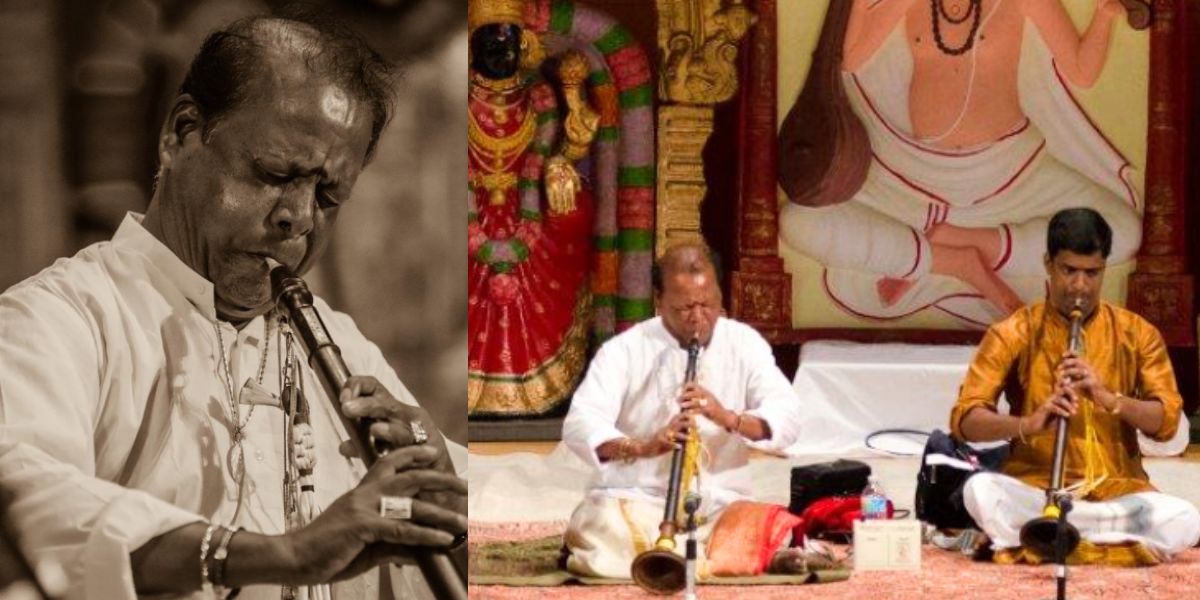
Seshampatti Sivalingam is one of the eight personalities from Tamil Nadu honoured with the Padma Award for 2024. (Supplied)
Padma Shri awardee and nadaswaram maestro Seshampatti T Sivalingam was only 17 when he left Dharmapuri for Thanjavur to fine-tune his nadaswaram-playing skills. His musical journey eventually took him to Madras (now Chennai), where he enrolled at the Government Music College to further his education.
During his student days, Sivalingam often travelled the lanes of Mylapore, dreaming of owning a home there. Once, when passing by an under-construction building on VC Garden Street, he silently wished for it to become his home.
“In 1981, I bought that house — a 650-square-foot home. It was just a dream when I was in my twenties, but it came true!” says Sivalingam, reflecting on his journey seated in the very same house, now transformed through several renovations.
Yet, this is not the only wish that materialised for Sivalingam. His aspiration to receive the Padma Shri award recently came to fruition, marking a significant milestone in his seven-decade career. Selected as one of the eight personalities from Tamil Nadu for the prestigious honour, Sivalingam’s dedication and hard work have been duly recognised.
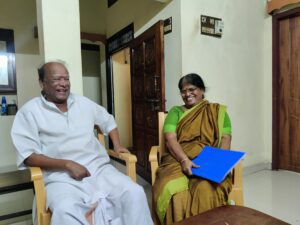
Seshampatti Sivalingam and Maheshwari at their home in Mylapore. (Roshne Balasubramanian/South First)
“Nothing in life comes easy. He wished for it and put in his dedication and hard work. This is a recognition for over six decades of effort,” says Maheshwari, Sivalingam’s partner of about half a century, expressing pride.
Clad in a white veshti and shirt, with a streak of kungumam on his forehead, Sivalingam pulls a chair and settles beside his wife. A single glance at him is enough to recognise that he has retained his simplicity despite the acclaim he has received.
The shelves in his house are filled with the numerous awards he has received over the years. “I’ve been asking him to display them on the walls. But he refuses!” says Maheshwari.
Some racks proudly display photographs capturing memorable moments of Sivalingam receiving awards from leaders such as MG Ramachandran, M Karunanidhi, J Jayalalithaa, Pranab Mukherjee, and even a picture with Dr APJ Abdul Kalam.
“I am blessed to have had the opportunity to receive awards from these doyens. It’s not just the awards, but the respect they had towards the art that touched me,” he says.
Recalling an incident from the past, at the World Tamil Conference in Madurai, Sivalingam was instructed to play until then Chief Minister MGR arrived. However, MGR, upon hearing Sivalingam play, expressed his desire to listen more. “Such was their admiration for the arts,” he says.
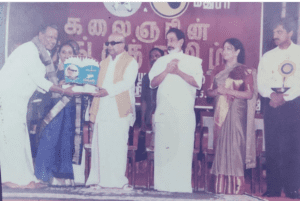
Felicitated by then Chief Minister of Tamil Nadu, M Karunanidhi. (Supplied)
Curious about whether he has had similar experiences in recent times, we ask. “Nowadays, functions are very strictly organised. There’s a lot of emphasis on adhering to schedules, and performers are often required to finish before the guests arrive… So, those kinds of experiences have become rare,” the 79-year-old tells South First.
“He possesses a remarkable work ethic. Even when our children were young, he couldn’t afford to spend much time with them during vacation time. The holidays often coincided with temple festivals and the wedding season, where he would perform. His dedication to his craft has never wavered; he holds deep reverence for it,” Maheshwari shares.
Growing up in Dharmapuri, Sivalingam’s musical journey began under the guidance of his father, Teerthagiri, who taught him the art of playing the nadaswaram. Balancing his days between tending to the fields and practising music at night, Sivalingam’s early years were filled with dedication to his craft.
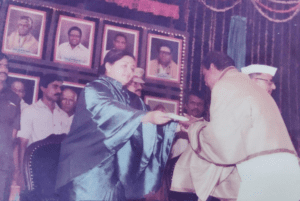
Receiving Kalaimamani State Government Award from then TN Chief Minister J Jayalalithaa (1993). (Supplied)
“My formal education ended in fifth grade. Instead, I accompanied my father to temple festivals and concerts to support our family,” he recalls, having started his musical journey at the tender age of 10.
Reflecting on his roots, Sivalingam acknowledges the limitations of pursuing music in a hamlet like Seshampatti in Dharmapuri compared to musical hubs like Thanjavur or Madras. “The musical atmosphere in my hometown was different. To thrive, I knew I had to seek opportunities beyond my village,” he shares.
It was a chance encounter with nadaswaram artiste Tiruvenkadu Masilamani at a temple that altered the course of Sivalingam’s life. Masilamani recognised his talent and suggested to Teerthagiri that Sivalingam should train in Thanjavur. However, financial constraints hindered this prospect.
Accepting the reality but remaining steadfast in his passion for the art, Sivalingam followed his heart. He set out on a journey to Thanjavur with whatever little he could gather. “The shift from the arid landscapes of Dharmapuri to the lush fields of Thanjavur was incredibly rejuvenating. It also nurtured my aspirations,” he shares.
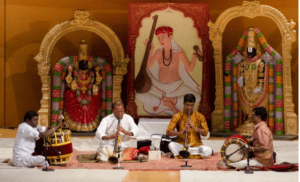
During a performance at Cleveland Thyagaraja Aradhana in the US. (Supplied)
There, under the tutelage of nadaswaram vidwan Keevalur NG Ganesan, Sivalingam’s musical education flourished.
“Everything was new to me — the place, the people,” he recalls. However, amid the apprehension, a memorable experience stood out: watching the iconic film Thillana Mohanambal (1968) at a local theatre in Nagapattinam, renowned for Sivaji Ganesan’s portrayal as a nadaswaram vidwan.
“I was thrilled to watch the film. It felt like a sign. However, the unfamiliar surroundings made me contemplate returning home,” he shares candidly.
Yet, fate had other plans for him, steering him towards his destined path. Several months later, an opportunity arose to go to Madras. Ganesan introduced Sivalingam to PS Veerusami Pillai, who offered him a letter of recommendation for the Government Music College.
However, Sivalingam, oblivious to the importance of the opportunity, declined it. “I was more inclined towards studying at a college in Pazhani, which was closer to home,” he shares.
“Madras appeared as distant as travelling to the US or UK for him back then,” Maheshwari laughs, reminiscing about Sivalingam’s initial apprehension.
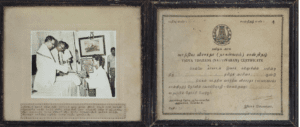
Vidya Visarada completion certificate (1972). (Supplied)
Upon learning of Sivalingam’s decision, another artiste, Keevalur Govindaraja Pillai, advised him to reconsider, emphasising the significance of the opportunity. “He said, ‘There are so many people waiting to go to Madras, and you shouldn’t let go of this opportunity,'” Sivalingam recalls. Realising the gravity of his choice, he returned to Veerusami Pillai, but sadly, the opportunity had already lapsed. “He informed me that the offer had expired and tore up the letter,” Sivalingam shares with a tinge of regret.
However, destiny had other plans in store. A stroke of luck came through his friend Sikkil Umapathy, who, being a student at the Government Music College, facilitated another chance for Sivalingam to study in Madras.
“He gave me a letter, and I was immediately asked to join the college. I enrolled for the Vadya Visaradha course,” Sivalingam recounts.
Under this new circumstance, Sivalingam became a disciple of Keeranur Ramaswami Pillai. He resided in a shared hut on St Mary’s Road, nestled within a keerai thottam behind the mosque. “The rent was close to ₹2 a month,” he recalls, reminiscing about the humble beginnings of his journey in Madras. Later on, Sivalingam continued his musical education under the guidance of Latchappa Pillai.
Amid the hustle and bustle of life in Madras, a series of moments solidified Sivalingam’s resolve to call Chennai his home. One such moment etched in his memory dates back to February 3, 1969, during the funeral procession of then Tamil Nadu Chief Minister CN Annadurai. Sivalingam found himself engulfed by a staggering crowd of 15 million mourners.
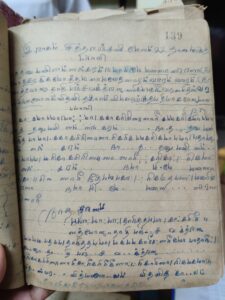
Archived music notes from Latchappa Pillai at Sivalingam’s residence. (Roshne Balasubramanian/South First)
“Upon hearing the news of his demise, I hastily boarded a bus to Chintadripet. The streets were overflowing, a surging sea of people,” he recalls vividly. However, amid the chaos, finding his way back proved to be a task. “I was tossed around in the crowd until finally I stumbled back to Mylapore the next morning at 6.30! It was a daunting experience, and I seriously considered retreating to Dharmapuri,” he shares, reminiscing about the overwhelming nature of the city.
Yet, it was his friend Muthiah who became his beacon of support and encouragement. “If not for him, his reassuring words, and his willingness to shelter me, I might have fled back home. He played an invaluable role in my journey,” Sivalingam expresses.
Since then, there’s been no turning back. When Sivalingam embraced Madras, the city reciprocated with a flood of opportunities. From serenading temple crowds to becoming the auspicious charm at weddings, from captivating audiences across the globe with his music to ascending to the status of an A-top artiste on All India Radio (AIR), his journey from Dharmapuri’s agricultural fields is nothing short of inspiring.
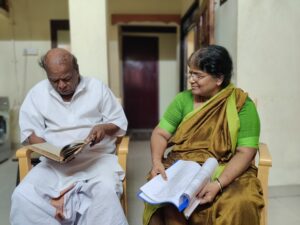
Maheshwari and her family are proud of Sivalingam’s achievements. (Roshne Balasubramanian/South First)
“In 1972, I auditioned for AIR and played ‘Shree Ganapathi’ in Sowrashtram ragam. To my surprise, right after, they asked me to come back the next day for a recording! With the ₹110 I earned that day, I made a beeline to the Tirupati temple, offering it as gratitude to God,” he shares. “And that’s where it all began – from being a B-grade artiste to climbing up the ranks to become an A-top artiste,” he adds, his voice brimming with the excitement of a journey filled with “divine blessings”.
“I am content today. My art enabled me to carve a name for myself, buy a home, provide education to my children, and earn respect in society,” he says with a smile.
“Do you ever wonder what would have happened if you hadn’t run away from Dharmapuri?” we ask.
“Life’s journey would have been different. But I wouldn’t be where I am today. I am glad I took that decision,” he shares reflectively.
Since the announcement of the Padma award, the residents of Seshampatti have been excited about his win. When the couple visited Dharmapuri after the announcement, they were greeted with posters bearing the words ‘Mannin Maindhan’ (Son of the Soil) in celebration. “They are proud of what he has achieved, and so are we,” shares Maheshwari, looking at him lovingly.
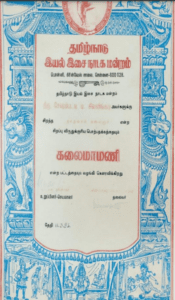
Kalaimamani award. (Supplied)
“However, in today’s world, the once bustling concert invitations have dwindled,” Sivalingam reveals. “Since the pandemic outbreak, artistes like us have felt the pinch. Marriages now come with packaged deals, leaving fewer openings for independent senior performers like myself. But amid these challenges, there are still those who recognise our dedication and seek out our melodies,” he adds. “And tomorrow,” he continues, “I’ll be performing at a wedding,” he shares.
He dedicates a minimum of two hours every day to practice and ensures he stays physically fit — taking a stroll to Marina Beach and visiting the Kapaleeshwarar temple are essential routines for the septuagenarian.
“Even if we travel abroad to visit our son in the US or another son living far from Mylapore, he always wants to return here soon. He can’t bear to be away,” reveals Maheshwari.
“Nothing can beat the soothing embrace of the sea breeze here,” Sivalingam muses. “I feel truly alive only in this place,” he adds, a sense of contentment in his voice as he savours the moment.
Sivalingam speaks of the challenges faced by Nadaswaram artistes. “The pursuit of mastery in our craft often leaves little room for formal education,” he acknowledges.
“I’ve learned that education is not just about textbooks; it’s about expanding our horizons and seizing new opportunities. Yet, formal education can pave the way for greater possibilities, enabling us to interact with the world in ways we never imagined. So, to all aspiring artistes, I urge you to embrace education alongside your passion for the arts.”
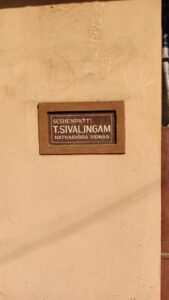
In 1981, Sivalingam purchased a house in Chennai. (Roshne Balasubramanian/South First)
He calls on the government to provide more support to traditional artistes, urges sabhas to include more nadaswaram concerts in their programmes, and encourages the public to increase awareness of this art form. “Our heritage is at stake,” he expresses.
“It’s imperative that schools integrate our art forms into their curriculum, and sabhas host more nadaswaram concerts. Not only will this elevate visibility, but it will also bolster the livelihoods of countless artists. We must nurture our cultural legacy, creating an environment where it can flourish and thrive.”
As we prepare to leave, we ask Sivalingam about his current dream. His response surprises us. “I’ve always believed that knowing when to step back is just as important as knowing when to push forward. It’s like composing a melody – you have to find the right moment to let the notes fade away gracefully. When my art isn’t at its peak, I want to recognise that moment and gracefully bow out. Ultimately, I hope to be remembered not for the quantity, but for the quality of my art,” he says, ready to head out for his evening walk.

Apr 26, 2024

Apr 25, 2024

Apr 25, 2024

Apr 24, 2024

Apr 21, 2024

Apr 19, 2024